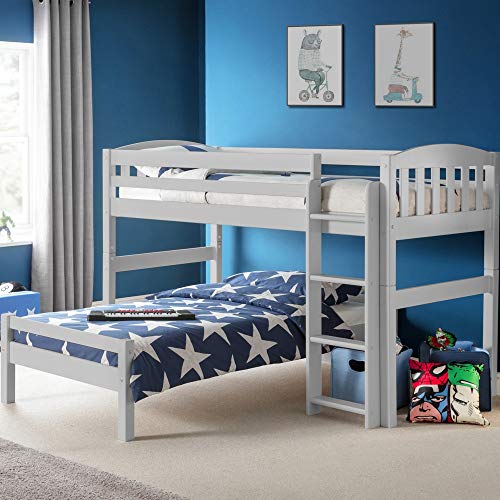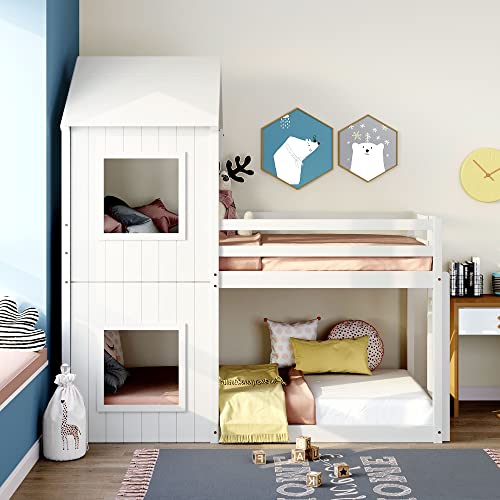TV 광고 The 9 Things Your Parents Taught You About Bunk Bed For Kids
페이지 정보

본문
 Choosing a Bunk Bed For kids bunk beds
Choosing a Bunk Bed For kids bunk bedsA bunk bed for children can bring siblings closer together and the feeling of sharing an adventure. It can also be able to accommodate an additional twin or full mattress at the bottom for sleepovers.
Before purchasing a bunkbed for your child, be sure to consider these safety tips. Make sure that the staircase and ladder are secured to the frame, and that any gaps in guard rails aren't large enough to allow strangulation.
Safety
Bunk beds for children are a great way to save space however, it's important to remember that they can also be dangerous if not properly set up and supervised. Make sure to choose a bunk bed with full-length guardrails on both sides of the top bed. Find a bunk bed that has been tested for safety by a third-party lab and is in compliance with all CPSC requirements. If you can, put the bunk beds in a room without doors or windows. This will stop children from leaving their beds at night.
Be aware of the capacity of your child's weight and their age range when deciding on a buy bunk beds bed. Some are made for young kids only, while others are able to accommodate teens and even adults. Decide if you prefer an trundle that is placed on the bottom or a twin mattress for two beds. In addition, if you're using the bed for more than two children, make sure the beds are compatible and that you have enough space in the room to accommodate both beds comfortably.
Some children are better at home sleeping on the top bunk. It's important to monitor them on a regular basis to ensure they are ready. Experts generally recommend that children less than six years old do not sleep on top bunk because they may lack the coordination and spatial awareness required to safely navigate the ladder and height of the upper bed.
If your children are often having friends who visit frequently, make sure they are aware of the rules for bunk beds, like not using the ladder and not hanging or rough-housing off the guardrails. In addition, you should encourage your children to keep items like belts, jewelry, and jump ropes away from the bunk bed, as these can pose a strangulation risk. Some bunk beds come with stairs instead of ladders which can provide security for children who aren't able to climb. Lights for night can be put on bunk beds for kids to help them safely navigate to and from the top bunk at night.
Space-Saving
Bunk beds make the most of the area, making space to study and play. While this is a great solution for kids' bedrooms but it can also be a a dramatic focal element in a dining or living area.
When choosing the best childrens bunk beds bunk bed for your kids take into consideration the dimensions of your space and their age. Children typically move to the top bunk at six or eight years old, when they begin to show the maturity and dexterity needed for this arrangement. You know your child best and you should evaluate their readiness and make sure they are comfortable and confident of the transition.
A lot of bunk bed designs include ladders or stairs that offer easy access to the higher level. Stairs can take up more space than ladders, however they are safer for kids as they learn to maneuver the bed's height. Some bunks come with a slide, which gives children a thrill each when they go to bed.
If you choose a bunk with stairs, opt for a design that provides plenty of storage options. This design from Lucy Harris Studio features a drawer under the stairs, which helps keep the bunks tidy and tidy.
Include a theme in the design of your bunk beds to make them feel more special. A bunk that is sporty is a fantastic option for children who enjoy football or baseball. A fairytale-themed bunk would be perfect for little girls. Bunks with a desk also provide a practical solution for children who have to finish their homework or work at home.
Bunk beds are a fantastic option for siblings who love spending time together but prefer the security and privacy of their own room. When it is time to host sleepovers for siblings, bunk beds allow the children to sleep comfortably without the need of the sofa or floor. In addition, only kids who share a room with a sibling will appreciate the option of having friends over for sleepovers, too.
Convenience
Bunk beds allow siblings to share one room without occupying valuable space. This allows children to develop, play and learn together, while enjoying their own space. It also makes it easier for parents with a busy family schedule to keep their home clean and manage their hectic schedule. Bunk bed designs offer many features that make the most of vertical space that is not being used and integrate well with any style of bedroom.
Bunk beds are a great way to save space and show your parenting style. Bunk and loft beds are available in a vast variety of sizes and styles that can be adapted to any room and include twin over full-size beds or twin over queen beds. Some models include built-in storage while others offer additional storage space, such as a twin or full trundle. These beds can also be reused later on when your kids outgrow them, as they can easily be converted into two separate single beds or even a daybed.
In addition to preserving space, lofts and bunks can bring a sense fun and adventure to any bedroom. Many children love the opportunity to take the top bunk and transform it into a fort or clubhouse. You can also invite your friends to stay for sleepovers or create a space in which they can play with their imaginations.
Spending more time with their siblings during the evening can also help them form stronger bonds. Regardless of their age gap being able to keep each other company through the rough patches of siblinghood can be a wonderful method to strengthen ties and encourage emotional development. Loft beds and bunk beds can be especially useful in accommodating older children with younger siblings, as they give the older child a chance to mentor the teen or tween and build a strong bond with them.
In the end, the best bunk bed for your child depends on your child's ability to safely climb up and down. The average child is ready for the top bunk around the age of six, but it's crucial to assess your child's mental and physical development. Physical development includes dexterity, coordination and ability to climb a ladder. Mental development is contingent on maturity and level.
Style
Bunk beds can bring a fun, playful touch to any room. They are great for friends or siblings who stay together. They let children express their individuality through the color, theme and design they select for their rooms. When it comes to choosing a bunk bed, there are many options to consider.
A conventional bunk bed is the most basic configuration. It is comprised of two twin beds that are stacked on top of one another. This configuration is ideal for siblings sharing a room, since it allows them to see each other easily even if they are on different floors. Many of the standard models of bunk beds offer customizable options that make it easy to find a bed that is suitable for any child's bedroom.
Some bunk beds also include particular features that make them more practical and fashionable. For instance, some come with under-bed storage drawers to keep the space under the bunks tidy and well-organized. It's easy to store clothes, bedding and other things. You can also add curtains or drapes to the bunk bed to provide some privacy when you sleep.
Other styles of bunk beds for kids include loft beds that elevate the mattress a few inches off the ground. This configuration saves space and provides a great spot to read, study or relax. It's also possible to add additional storage space by installing shelves or a desk.
The last option is to pick an aesthetically pleasing bunk bed that is a perfect fit with the overall theme of the room. Bunk beds can be designed in the shape of castles, trees or pirate ships. This will add a fun element to any bedroom for children. These themed bunks can inspire imagination and encourage creative play.
It's crucial to consider your child's maturity and age when deciding if bunk beds are the best bunk beds choice for him or her. It is generally accepted that children should transition to the top bunk at the age of 6 or 7. However, you will be able to determine whether your child is able and capable of sleeping on elevated furniture.

- 이전글A Beautifully Refreshing Perspective On Daycare Near Me 24.10.17
- 다음글Objevte konečné výhody kasina Mostbet – vaší brány k vzrušující zábavě 24.10.17
댓글목록
등록된 댓글이 없습니다.
